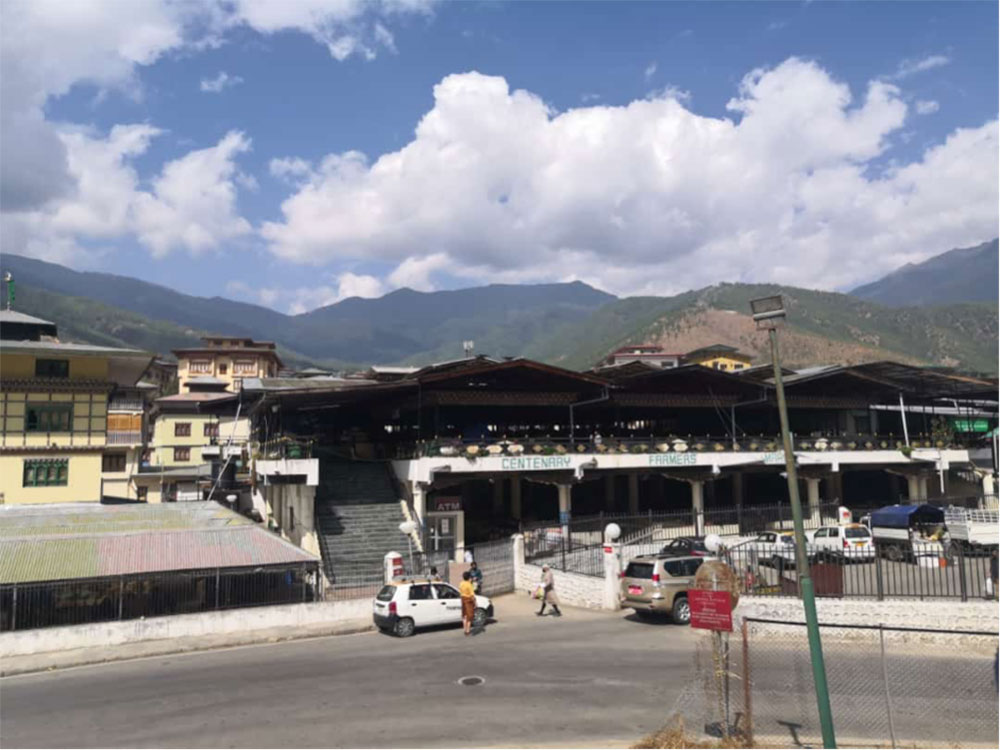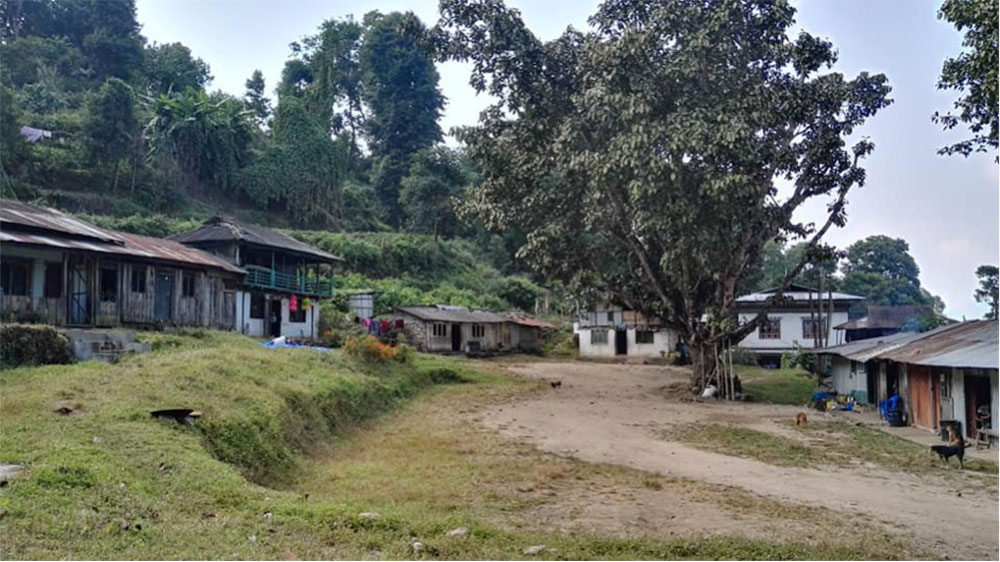Mendrelgang is a gewog under Tsirang. Its old name was Lamidara. It was a drungkhag from 1965 to 1990. It is located 20km from Damphu the dzongkhag headquarters. It is an old village with its own identity and culture. A weekly market (haat bazaar) was established in the first half of 20th century, as per oral recitation. A school was opened in 1959 and in 1965 an SDO (sub-division office or drungkhag) was established. These three facilities co-existed in the same location, within an acre of land. To ease the pressure on the school’s functioning a new site was identified, acquired for the Haat Bazaar, and plots were allocated to shop owners in 1965-66. All were called and allocated combined plots adequate to accommodate two or more shops. There were three rows of shops for retailing, some store sites, and eateries. The space between rows of sheds was for villagers to display their products. The shops included groceries, clothing, eateries, bars, space for the trading of animals and open space for slaughtering buffaloes. It was like an open restaurant where local drinks were served with meat.
Haat bazaar
It was common in southern Bhutan to have a market place, popularly known as haat bazaar for essential goods like groceries, sale of surplus farm products, dairy products and meat. Villagers, shopkeepers and civil servants visited such markets essentially for vegetables. It served as a place for outing for the villagers. The market was on Tuesdays and teachers had morning shift till 12pm and afternoon was free for shopping. The system of bartering between villagers was prevalent as the cash was rare.
Communication centre
These bazaars served as communication centre for government announcements by reading aloud the contents of circulars for the benefit of illiterates. The announcer would draw the attention of people by beating a drum and shouting at the top of his voice to convey public announcements. The bazaar also had a post office, the office for malaria eradication programme, and Food Corporation of Bhutan.

CFM, Thimphu
The people visited the bazaar to deliver letters, invite people to social events, labour force for farming and transact other businesses like contract sale of cash crops. Transaction of animals was also carried out even without seeing the animals. It had the downtown function and served the purpose of present-day mobile phones and internet.
Cultural centre
The bazaar served as an entertainment centre for the purpose of escaping from the daily farm work or grazing the animals. The entertainment meant escaping work for a day meeting friends and relatives buying some clothing from their savings. They would also dress in the best of their attires. In the border towns entertainment like animal show, magic, gambling, roller coaster, makeshift cinema halls, and even some cultural programmes were organised during winter and were mostly operated by people from across the border.
There was also an elite group who would ride a horse to the bazaar to transact some business after which they would enter the eateries drink jad or rakshi with the buffalo meat and get high. As they return home they would also stop in the eateries, located outside, along the routes for snacks. The popular snacks were “sell roti”, boiled and fried eggs, and meat. It was fun for them after the day’s business.
Besides these, the bazaar served as a meeting place for youngsters. Youngsters would find their life partners here.
Bazaar culture
The culture of establishing a bazaar was quite popular in Tsirang and other dzongkhags of southern Bhutan. The oldest bazaar was Changchey, which opened in the late nineteenth century. It was located in a deep valley surrounded by villages and farms. Its specialty in bamboo craft from Semjong was popular. People from the whole dzongkhag would travel for hours to buy those products. Burichhu haat bazaar was opened in the first half of the 20th century. Now it is open on Sundays and the settlement is formalised as the government has given land to the shopkeepers. Lamidara was open on Tuesdays, Tshokana on Wednesdays, and Dhajay on Saturdays. With the establishment of Sipahi Dhura (police camp) in Damphu in the 1950s, a football ground was constructed with labour contribution from villagers in 1953. Later a football tournament was introduced with a trophy contributed by Ash Bahadur Subba, the then District Commissioner (DC) of Tsirang. A small structure where Damphu School initially started served as a restaurant during tournaments. Gradually, it became a bazaar on Sundays and since 1970 it became an all-time bazaar.
Similarly, such markets existed in other places like Gola Bazzar (shifted to Belbotey), Ghumauney, Chengmari, Samtse, Samdrupjongkhar, Kalikhola, Goshi, Gelephu, Sarpang, and Phuentsholing. All these markets were established during the first half of the 20th century. These bazaars are very popular and they specialised in certain farm products. In the border areas, vegetable vendors and small merchants would come from the other side of the border. But more important is the interaction of the people and buying of essential goods.
Other dzongkhags
With growing urbanisation and the need to provide fresh vegetable, to promote sale of surplus vegetable and dairy products, weekly markets gradually spread across the country. Thimphu started a vegetable shop in front of Tashichhodzong gate, which was later shifted to the present day Centenary Farmers Market (CFM). Initially, there were a few sheds where villagers and vendors sold vegetables on Sundays. It became known as Sunday market and/or Sabji Bazaar. It was managed by the thromde office. Some staff would collect small amount from the shopkeepers as rent for use of space. There was no fixed rate and the collector decided the amount to be paid. It is still a mystery how those collectors submitted their account to the office. Having realised such anomalies, His Majesty the Fourth King ordered the then Secretary of National Urban Development Corporation to do away with such collection from the farmers. However, those who were importing from outside were expected to pay the service charge.
The then Ministry of Agriculture realised that increasing farm products should be complemented by marketing strategy. They hired a Bhutanese architect to plan a two-storey building and mobilised funds for construction. The plan was approved and executed. During the construction phase of this building, the Bazaar was temporarily shifted to the YHS ground. The building was completed and inaugurated to celebrate the 100 years of Wangchuck dynasty and named “Centenary Farmers Market”. The management was taken over by the BAFRA (Bhutan Agriculture and Food Regulation Authority). They have made many changes from the initially approved plan. The grains are still sold in the three rows of traditional sheds, constructed earlier, located adjoining CFM. Similarly, the non-food items (handicrafts and curio shops) are accommodated on the other side of the river connected by a traditional trail bridge.
The CFM market has allocated the first floor for local products and ground floor for imported vegetables. However, many vendors cheat the customers by selling imported vegetables and fruits as local farm products. A few years back a person from Gelephu was looking for a lift to Thimphu on a Thursday as he missed all the public transport. He was informed that a Bhutanese van travels with vegetable from Dadghari, the Indian settlement adjoining Gelephu late on Thursdays. He managed to contact the van owner and got a lift. The next day, he went to CFM and found that this vendor was selling those vegetables as Tsirang products. The space is allocated with good faith that the farmers will produce genuine and organic vegetables and sell their surplus to earn their livelihood. Unfortunately, there are some middlemen who can go to any extent for fast buck and create misunderstanding between farmers and consumers. For the regulators it is very hard to distinguish the origin of products and sometimes it is intentionally ignored.
Urban indicators
Similarly, such markets are constructed in every urban settlement as a place for selling their surplus farm products. The objective is to facilitate the farmers to augment their income and raise living standards. The urban population has to buy the essentials and therefore, it is best to buy the fresh local products. Today there are market sheds at Trashigang, Trahiyantze, Mongar, Gyalpoishing, Lingmethang, Bumthang, Trongsa, Wangdue, Punakha, Dagana, Gedu, Paro, and Haa.
The respective dzongkhags are also constructing vegetable sheds along the highways for the farmers to have easy access to sell their surplus products, in strategic locations. The markets whether in urban centres or the highway serve as excellent linkage between rural and urban setting.
It was recognised that in the absence of any established parameters the existence of Haat bazaar was considered an indicator for urbanization. Such settlements were included in the taxation policies of 1987 and 1992 as there were many off farm activities like schools, offices. In 1996, land compensation rules were framed wherein categorisation of urban settlements was introduced based on the existing facilities including weekly markets.
Urban policies
Rapid urbanisation influenced the first and second parliament to declare the urban centres of different categories. In 2010, Class A and B towns were declared. In 2015, such categorisation was removed and dzongkhag and yenlag throms were declared. The Article 22 of the Constitution provides establishment of local governments. The Dzongkhag Tshogdu shall consist of Gups, Mangmis, the Thromde representative, and one member of Yenlag Throms. The declaration of urban centres necessitates the establishment of local government in each Thromde. The first elected government established four thromdes. In 2015, the second elected government desired to establish 20 Dzongkhag Thromdes but was deferred by a Supreme Court order.
In the context of Tsirang, Mendrelgang was declared Yenlag Throm and Changchay was dropped. The constitution says at least one yenlag throm should be there, indicating that there could be more. Though Changchay was established in the early 19th century the Dzongkhag Administration has removed all shop owners that did not have land title. The removal of such facilities squarely on the basis of land ownership is depriving them a convenient location and encouraging shopkeepers, vendors and villagers to travel to Damphu, thereby undermining the spirit of decentralization and balanced development. A settlement that existed for more than a century has been removed. On the other hand, a similar settlement at Burichhu has been legalised as the house owners are given thrams.
Rural-urban linkage
The weekly markets have created opportunities both to the farmers and businessmen. In fact, these centres are serving as excellent linkages between rural and urban settings. While some are still developing, many located in the bigger towns are thriving. Today, these centres serve as information hubs, social places including some entertainment and are commercial hubs where fresh vegetables, fruits, goods at reasonable price, local grains and even handicrafts are available. They defuse the bigger markets. It is a perfect setting for informal economy as employment in the formal setting is increasingly becoming difficult.
Contributed by
Meghraj Adhikari
Former Civil servant


